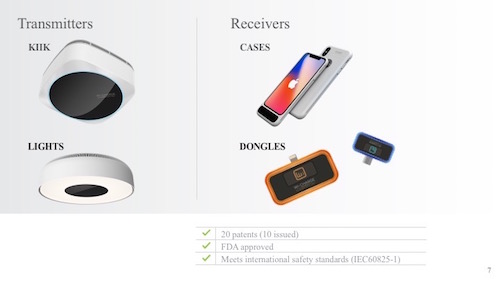Wi-Charge Startup Taps Infrared Technology for Wireless Charging Bid

The current WiCharge consists of a transmitter unit, designed in a format like a light fixture, and a dongle for the mobile device. Image Courtesy of WiCharge
Latest News
January 12, 2018
Just as the uptick in demand for mobile devices fed consumer hunger for ubiquitous Wi-Fi, the continuous proliferation of new offerings, coupled with the burgeoning internet of things (IoT) market, is fueling a similar need for ubiquitous battery charging, or so contends a startup focused on solving the problem.
Wi-Charge is creating what it calls an “Autonomous Charging” infrastructure, where devices tap into power as they need it to maintain usable power levels and without any kind of human intervention. As part of its vision, the company also believes devices should be able to be charged where they are used, whether that’s in the home, an office or a public space.
 Wi-Charge chose infrared because Autonomous Charging requires a beam with the shortest possible wavelength, allowing for concentration that controls divergence over a usable distance. Image Courtesy of Wi-Charge
Wi-Charge chose infrared because Autonomous Charging requires a beam with the shortest possible wavelength, allowing for concentration that controls divergence over a usable distance. Image Courtesy of Wi-Charge“The proliferation of wireless devices in our lives calls for them to be frequently recharged or a battery replaced—that is a big nuisance,” notes Victor Vaisleib, CEO of Wi-Charge, who says companies like his have been working on the design challenge for the last decade. “As we thought about the problem, we determined the solution was not better batteries, but autonomous charging—creating an infrastructure that would let all those devices charge themselves.”
As it delved into design exploration, Wi-Charge determined that the untethered lifestyle called for a wireless, over-the-air solution that would deliver a sufficient charge over a reasonable distance, use components small enough to accommodate typical mobile devices and forthcoming internet-of-things (IoT) sensors, and be safe enough for humans in close proximity.
One of the biggest engineering challenges has to do with the laws of physics as it relates to sending energy over the air, Vaisleib explains. As energy gets further from a transmitter, beams diverse or diffuse, which means too little energy goes where it’s needed to go, making for insufficient power, and too much goes where it’s not needed, which can cause safety issues, he explains. “If you want a reasonably sized transmitter that can deliver power to small devices like a phone over on the side of a room, what you get with most technologies is a huge cone of energy spreading all around, with only a small fraction available to harvest for the device,” he says. “In addition, there would be a huge zone that would be unsafe to stay in.”
The company’s Autonomous Charging solution, unveiled this week at the Consumer Electronics Show, uses infrared technology to deliver wireless, over-the-air charging. The system, covered by 10 patents with nine more pending, has been in development for five years. It consists of a transmitter unit, modeled much like a light fixture to deliver power to receivers anywhere in the vicinity, and a receiver unit, for each device, which captures the light from the transmitter and coverts it into electric power using a photovoltaic cell. Intelligence built into the transmitter and receiver automatically identifies chargeable devices to create the automatic charging while discovering their power requirements to adjust accordingly.
 The current Wi-Charge consists of a transmitter unit, designed in a format like a light fixture, and a dongle for the mobile device. Image Courtesy of Wi-Charge
The current Wi-Charge consists of a transmitter unit, designed in a format like a light fixture, and a dongle for the mobile device. Image Courtesy of Wi-ChargeThe design choice of infrared as a power sources addresses the diverging beam problem because it enables the ability to focus energy on very small client devices, Vaisleib says. The tradeoff for choosing infrared as an energy source meant Wi-Charge had to expend more design effort on creating a safety enclosure that would pass regulatory standards. “No system is water tight—there’s always some energy escaping,” he explains. “We needed to make sure what we were delivering on a practical level is a system that would pass all regulatory hurdles and be safe.”
With regulatory clearance achieved, Wi-Charge is moving on to showing prototype at CES and launching its first commercial product, aimed at B2B customers, not consumers, later this year. The system will be designed to deliver autonomous charging for commercial properties such as coffee shops, restaurants, hotels and schools, and Wi-Charge is also working with OEMs to integrate the capabilities within mobile handsets.
For its second-generation offerings, Wi-Charge is targeting makers of IoT devices for its autonomous charging capabilities. Given the projected proliferation of IoT devices—IDC’s worldwide IoT forecast is projecting 30 billion IoT things by 2020—power sources, and in particular, autonomous charging capabilities, will be a significant requirement.
Watch this video to how Wi-Charge works in concept.
Subscribe to our FREE magazine, FREE email newsletters or both!
Latest News
About the Author
Beth Stackpole is a contributing editor to Digital Engineering. Send e-mail about this article to [email protected].
Follow DE





